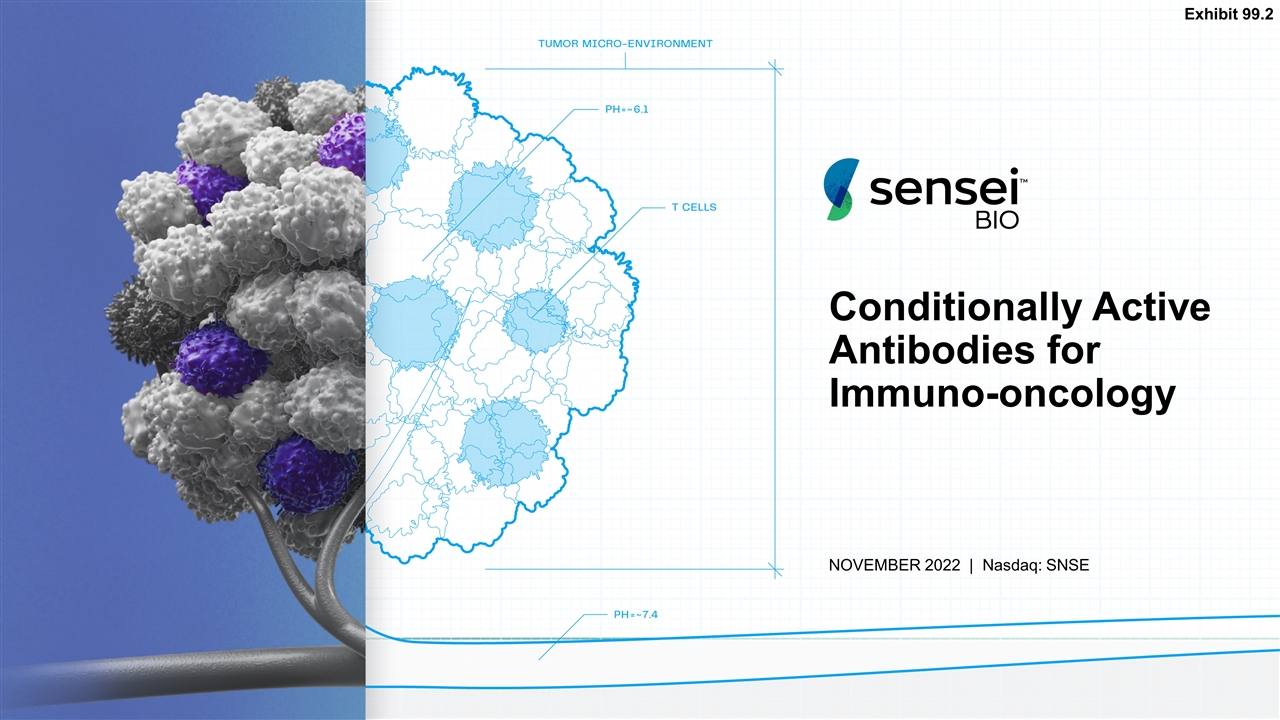
Conditionally Active Antibodies for Immuno-oncology NOVEMBER 2022 | Nasdaq: SNSE Exhibit 99.2
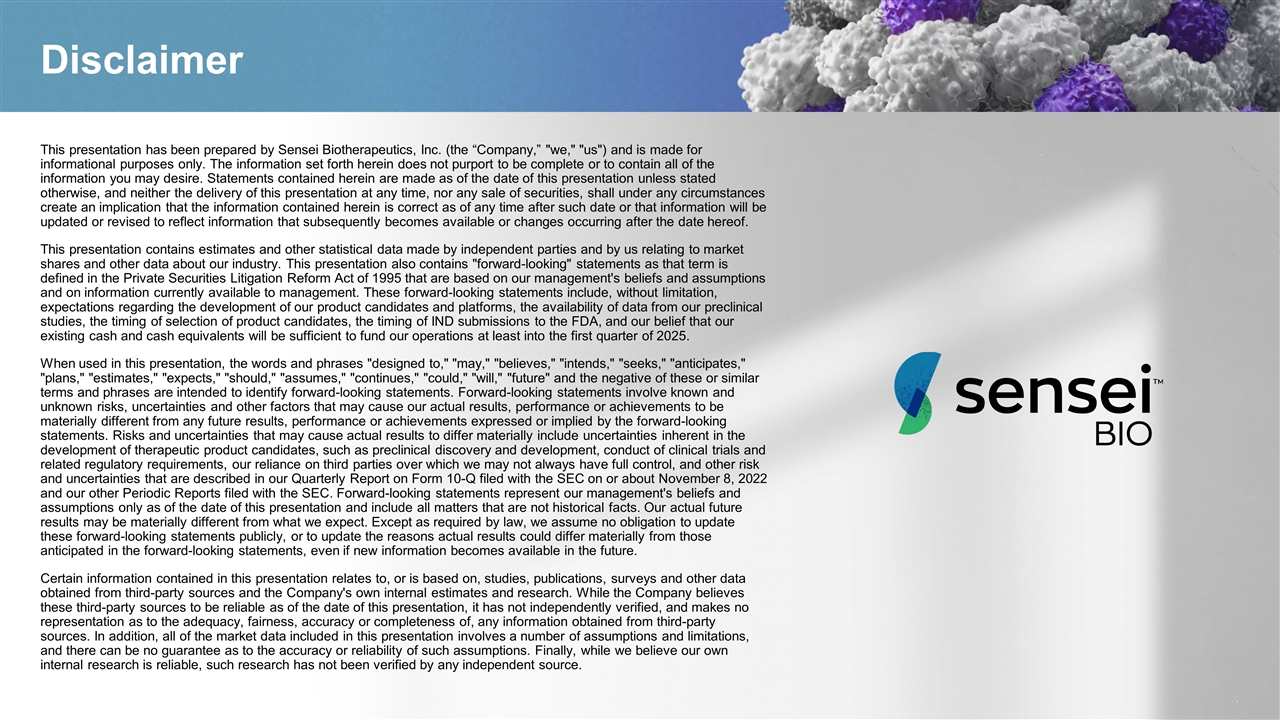
Disclaimer This presentation has been prepared by Sensei Biotherapeutics, Inc. (the “Company,” "we," "us") and is made for informational purposes only. The information set forth herein does not purport to be complete or to contain all of the information you may desire. Statements contained herein are made as of the date of this presentation unless stated otherwise, and neither the delivery of this presentation at any time, nor any sale of securities, shall under any circumstances create an implication that the information contained herein is correct as of any time after such date or that information will be updated or revised to reflect information that subsequently becomes available or changes occurring after the date hereof. This presentation contains estimates and other statistical data made by independent parties and by us relating to market shares and other data about our industry. This presentation also contains "forward-looking" statements as that term is defined in the Private Securities Litigation Reform Act of 1995 that are based on our management's beliefs and assumptions and on information currently available to management. These forward-looking statements include, without limitation, expectations regarding the development of our product candidates and platforms, the availability of data from our preclinical studies, the timing of selection of product candidates, the timing of IND submissions to the FDA, and our belief that our existing cash and cash equivalents will be sufficient to fund our operations at least into the first quarter of 2025. When used in this presentation, the words and phrases "designed to," "may," "believes," "intends," "seeks," "anticipates," "plans," "estimates," "expects," "should," "assumes," "continues," "could," "will," "future" and the negative of these or similar terms and phrases are intended to identify forward-looking statements. Forward-looking statements involve known and unknown risks, uncertainties and other factors that may cause our actual results, performance or achievements to be materially different from any future results, performance or achievements expressed or implied by the forward-looking statements. Risks and uncertainties that may cause actual results to differ materially include uncertainties inherent in the development of therapeutic product candidates, such as preclinical discovery and development, conduct of clinical trials and related regulatory requirements, our reliance on third parties over which we may not always have full control, and other risk and uncertainties that are described in our Quarterly Report on Form 10-Q filed with the SEC on or about November 8, 2022 and our other Periodic Reports filed with the SEC. Forward-looking statements represent our management's beliefs and assumptions only as of the date of this presentation and include all matters that are not historical facts. Our actual future results may be materially different from what we expect. Except as required by law, we assume no obligation to update these forward-looking statements publicly, or to update the reasons actual results could differ materially from those anticipated in the forward-looking statements, even if new information becomes available in the future. Certain information contained in this presentation relates to, or is based on, studies, publications, surveys and other data obtained from third-party sources and the Company's own internal estimates and research. While the Company believes these third-party sources to be reliable as of the date of this presentation, it has not independently verified, and makes no representation as to the adequacy, fairness, accuracy or completeness of, any information obtained from third-party sources. In addition, all of the market data included in this presentation involves a number of assumptions and limitations, and there can be no guarantee as to the accuracy or reliability of such assumptions. Finally, while we believe our own internal research is reliable, such research has not been verified by any independent source.
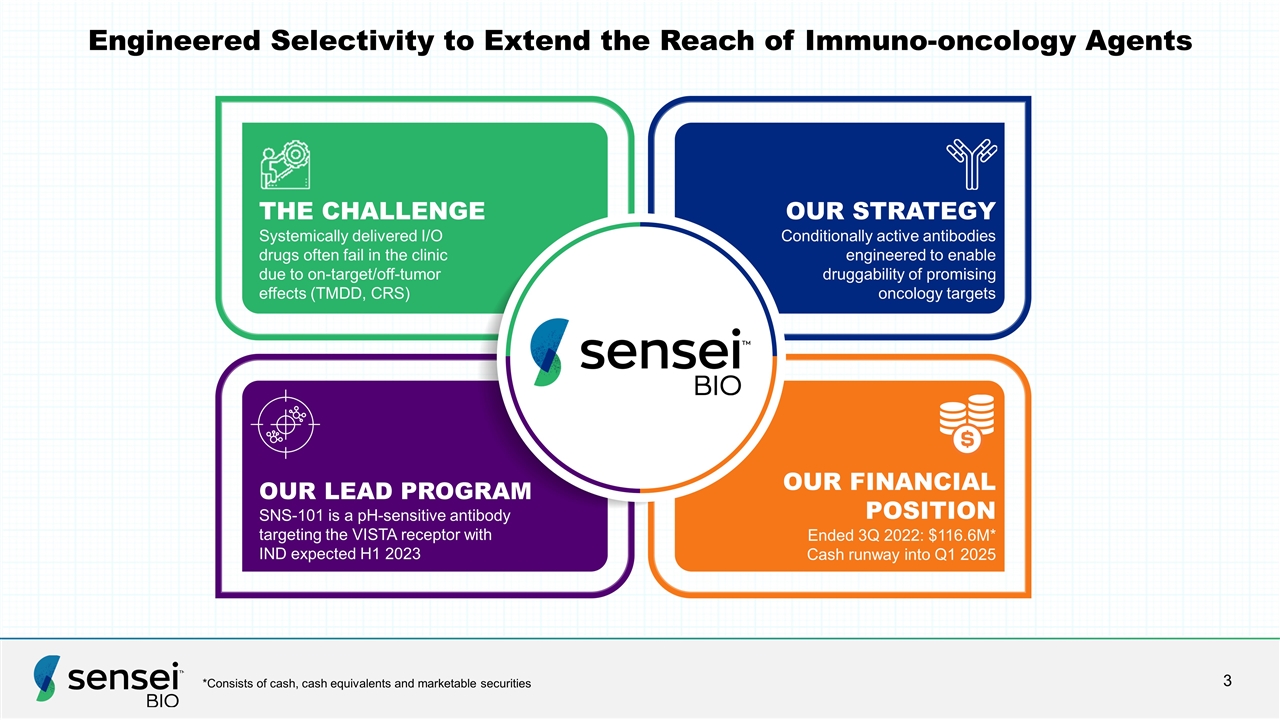
Engineered Selectivity to Extend the Reach of Immuno-oncology Agents THE CHALLENGE Systemically delivered I/O drugs often fail in the clinic due to on-target/off-tumor effects (TMDD, CRS) OUR FINANCIAL POSITION Ended 3Q 2022: $116.6M* Cash runway into Q1 2025 OUR STRATEGY Conditionally active antibodies engineered to enable druggability of promising oncology targets OUR LEAD PROGRAM SNS-101 is a pH-sensitive antibody targeting the VISTA receptor with IND expected H1 2023 *Consists of cash, cash equivalents and marketable securities
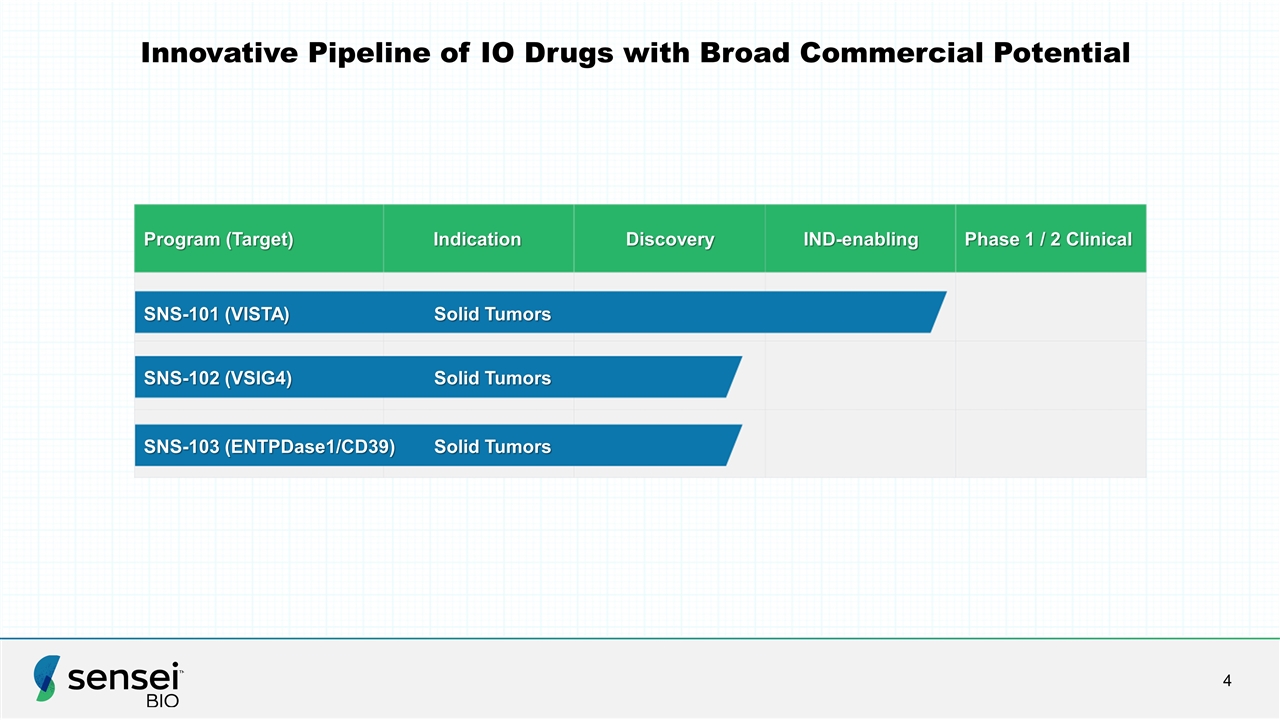
Innovative Pipeline of IO Drugs with Broad Commercial Potential Program (Target) Indication Discovery IND-enabling Phase 1 / 2 Clinical SNS-101 (VISTA) SNS-102 (VSIG4) SNS-103 (ENTPDase1/CD39) Solid Tumors Solid Tumors Solid Tumors
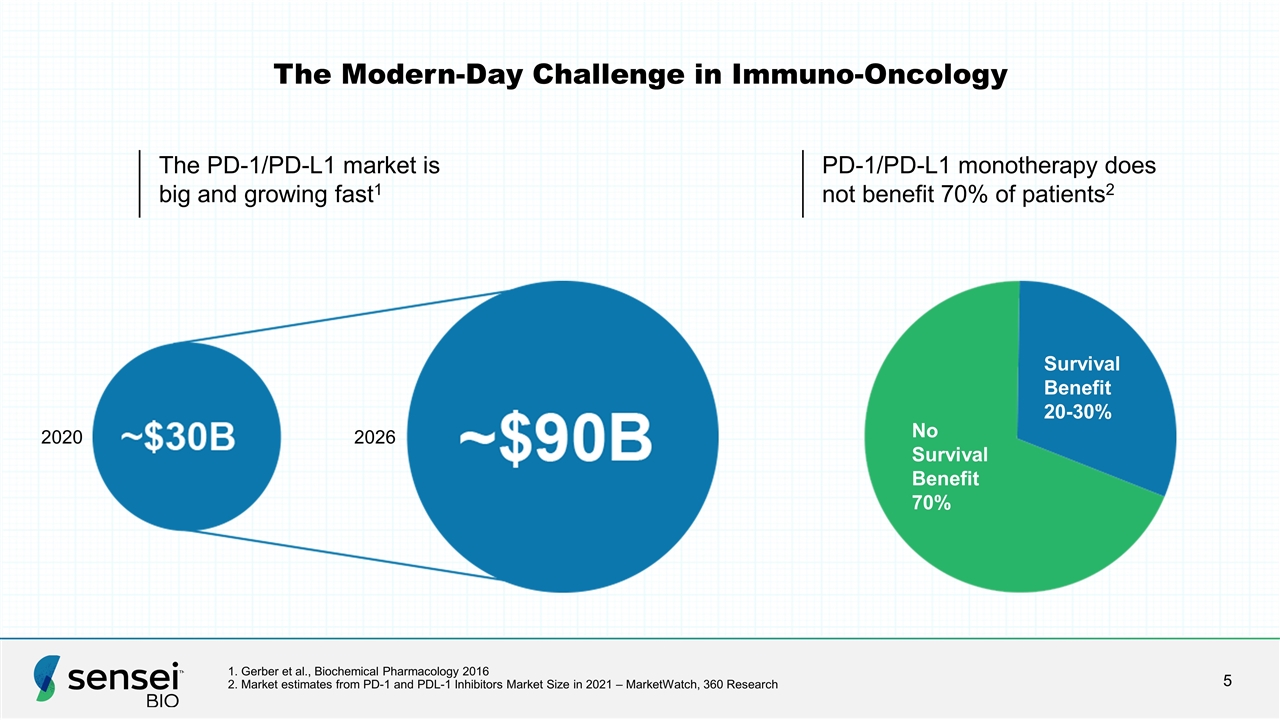
The Modern-Day Challenge in Immuno-Oncology The PD-1/PD-L1 market is big and growing fast1 PD-1/PD-L1 monotherapy does not benefit 70% of patients2 2020 2026 Survival Benefit 20-30% No Survival Benefit 70% 1. Gerber et al., Biochemical Pharmacology 2016 2. Market estimates from PD-1 and PDL-1 Inhibitors Market Size in 2021 – MarketWatch, 360 Research
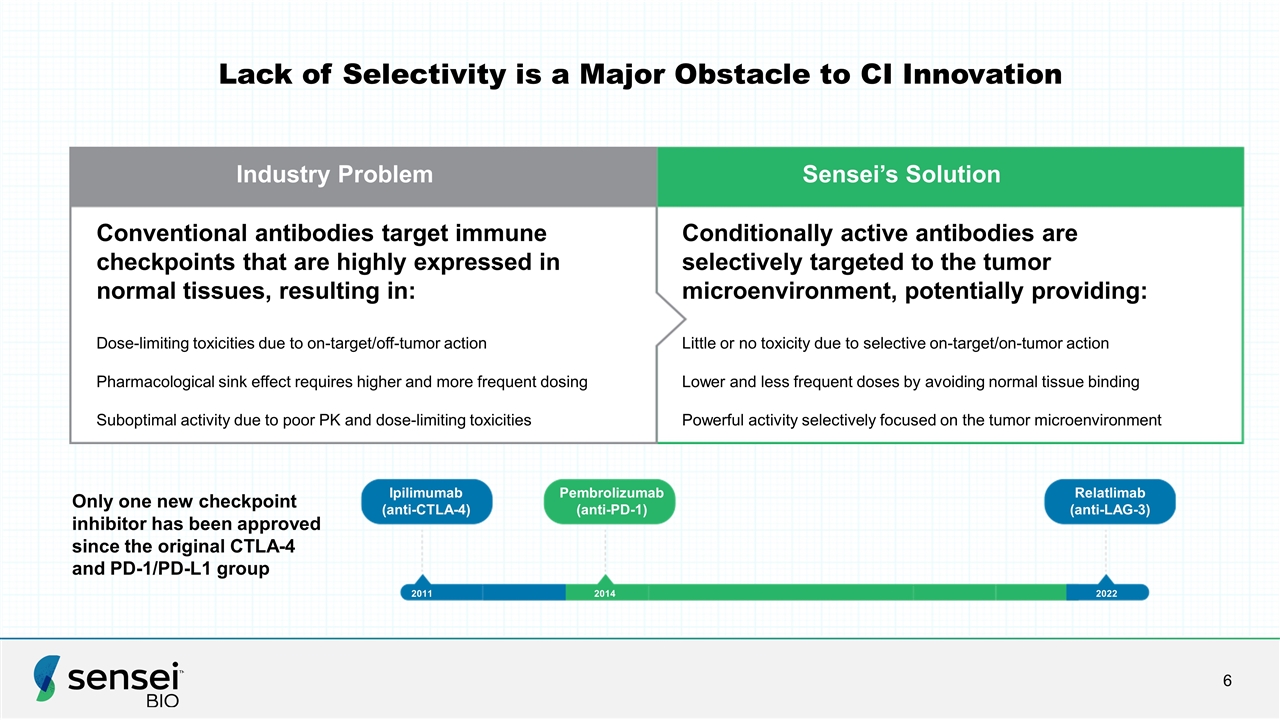
Lack of Selectivity is a Major Obstacle to CI Innovation Industry Problem Sensei’s Solution Conventional antibodies target immune checkpoints that are highly expressed in normal tissues, resulting in: Dose-limiting toxicities due to on-target/off-tumor action Pharmacological sink effect requires higher and more frequent dosing Suboptimal activity due to poor PK and dose-limiting toxicities Conditionally active antibodies are selectively targeted to the tumor microenvironment, potentially providing: Little or no toxicity due to selective on-target/on-tumor action Lower and less frequent doses by avoiding normal tissue binding Powerful activity selectively focused on the tumor microenvironment Only one new checkpoint inhibitor has been approved since the original CTLA-4 and PD-1/PD-L1 group Ipilimumab (anti-CTLA-4) Pembrolizumab (anti-PD-1) Relatlimab (anti-LAG-3) 2011 2014 2022
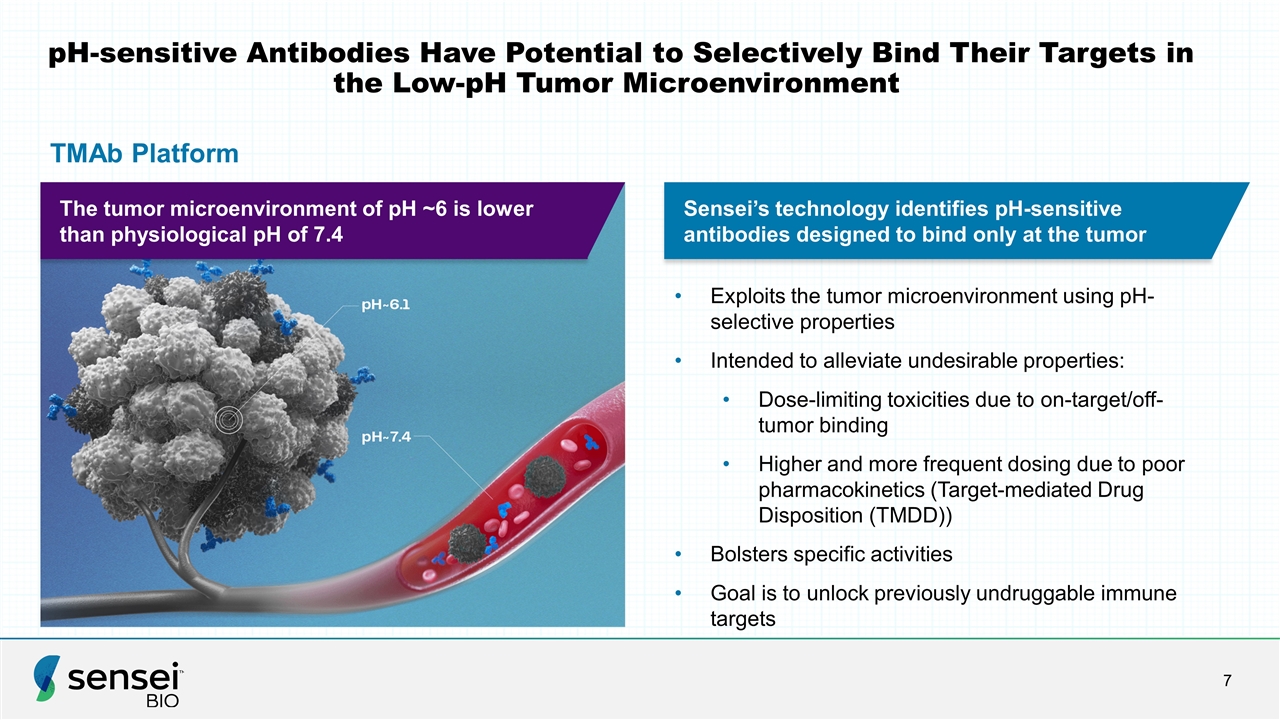
pH-sensitive Antibodies Have Potential to Selectively Bind Their Targets in the Low-pH Tumor Microenvironment Exploits the tumor microenvironment using pH-selective properties Intended to alleviate undesirable properties: Dose-limiting toxicities due to on-target/off-tumor binding Higher and more frequent dosing due to poor pharmacokinetics (Target-mediated Drug Disposition (TMDD)) Bolsters specific activities Goal is to unlock previously undruggable immune targets TMAb Platform Sensei’s technology identifies pH-sensitive antibodies designed to bind only at the tumor The tumor microenvironment of pH ~6 is lower than physiological pH of 7.4
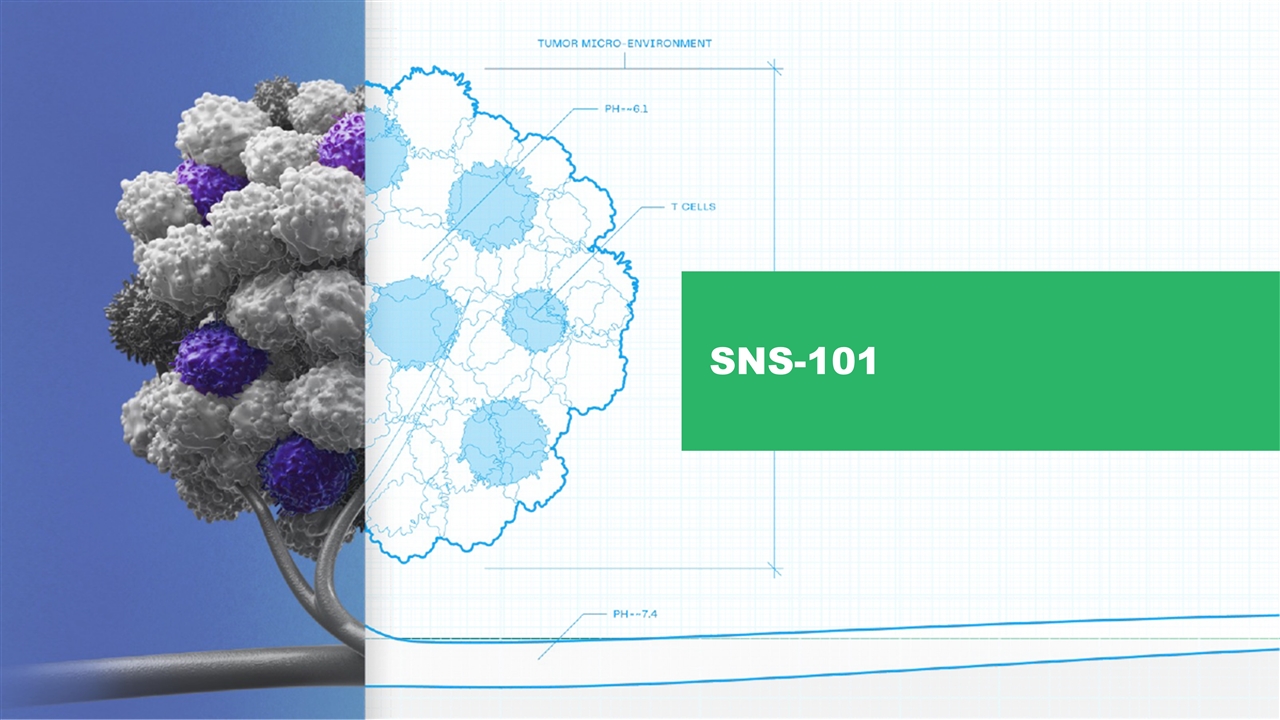
SNS-101

VISTA: A Potent T cell Checkpoint Extensively Expressed on Myeloid Cells1 1. Lines et al. Cancer research vol. 74,7 (2014) VISTA is a B7 family member that suppresses T cell function T-cell proliferation & activation
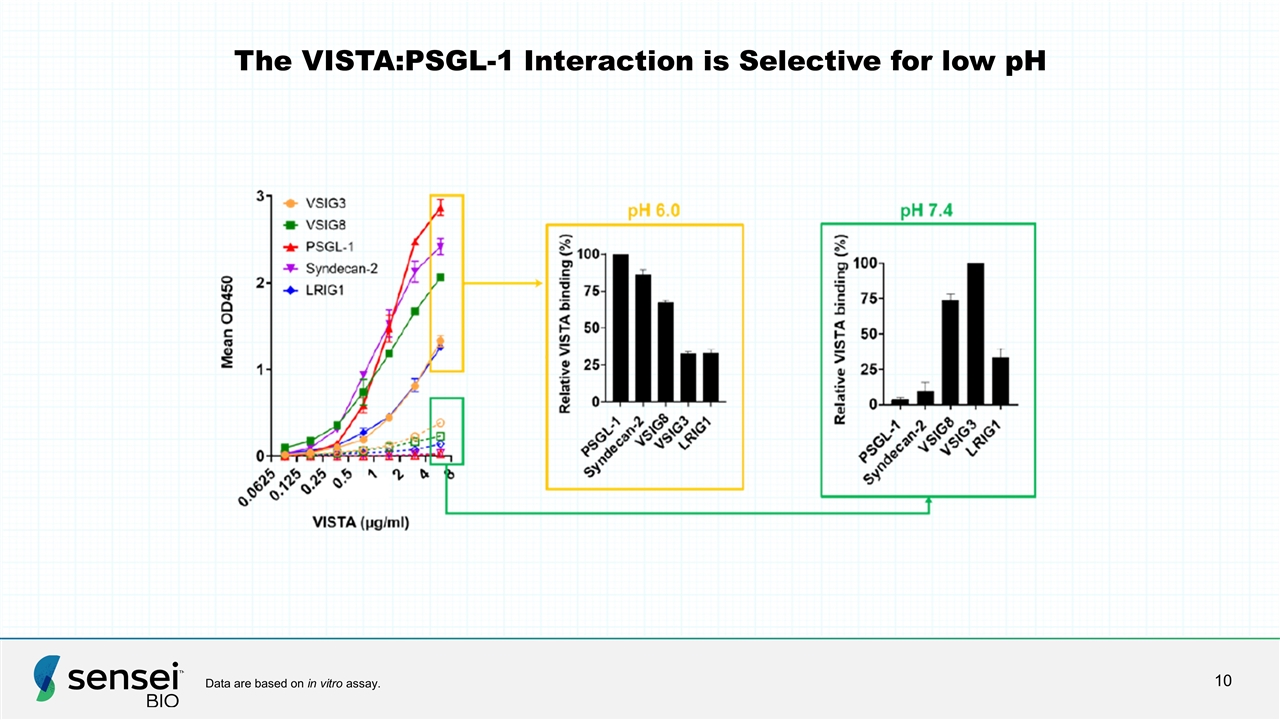
The VISTA:PSGL-1 Interaction is Selective for low pH Data are based on in vitro assay.

VISTA Checkpoint is Activated at the Low pH of the Tumor Microenvironment 1. Johnston et al., Nature 2019 VISTA extracellular domain is uniquely rich in histidines¹ Protonated VISTA histidines are required for PSGL-1 binding1
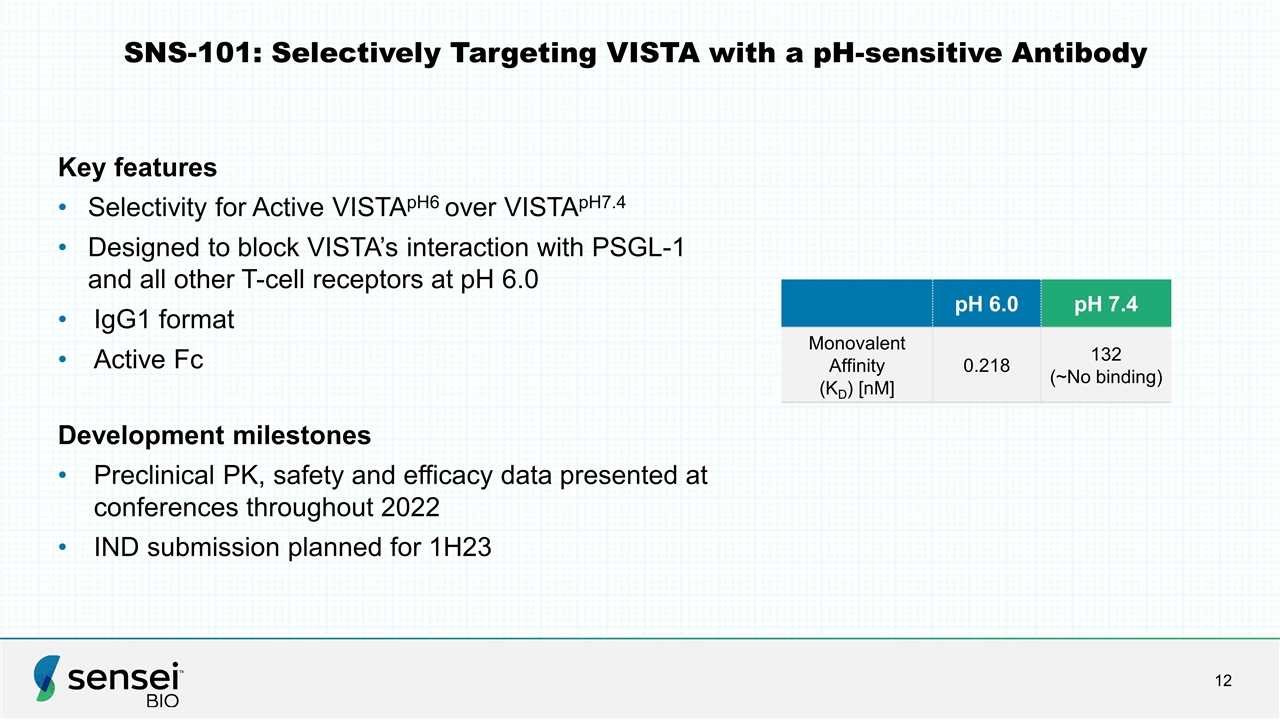
SNS-101: Selectively Targeting VISTA with a pH-sensitive Antibody pH 6.0 pH 7.4 Monovalent Affinity (KD) [nM] 0.218 132 (~No binding) Key features Selectivity for Active VISTApH6 over VISTApH7.4 Designed to block VISTA’s interaction with PSGL-1 and all other T-cell receptors at pH 6.0 IgG1 format Active Fc Development milestones Preclinical PK, safety and efficacy data presented at conferences throughout 2022 IND submission planned for 1H23
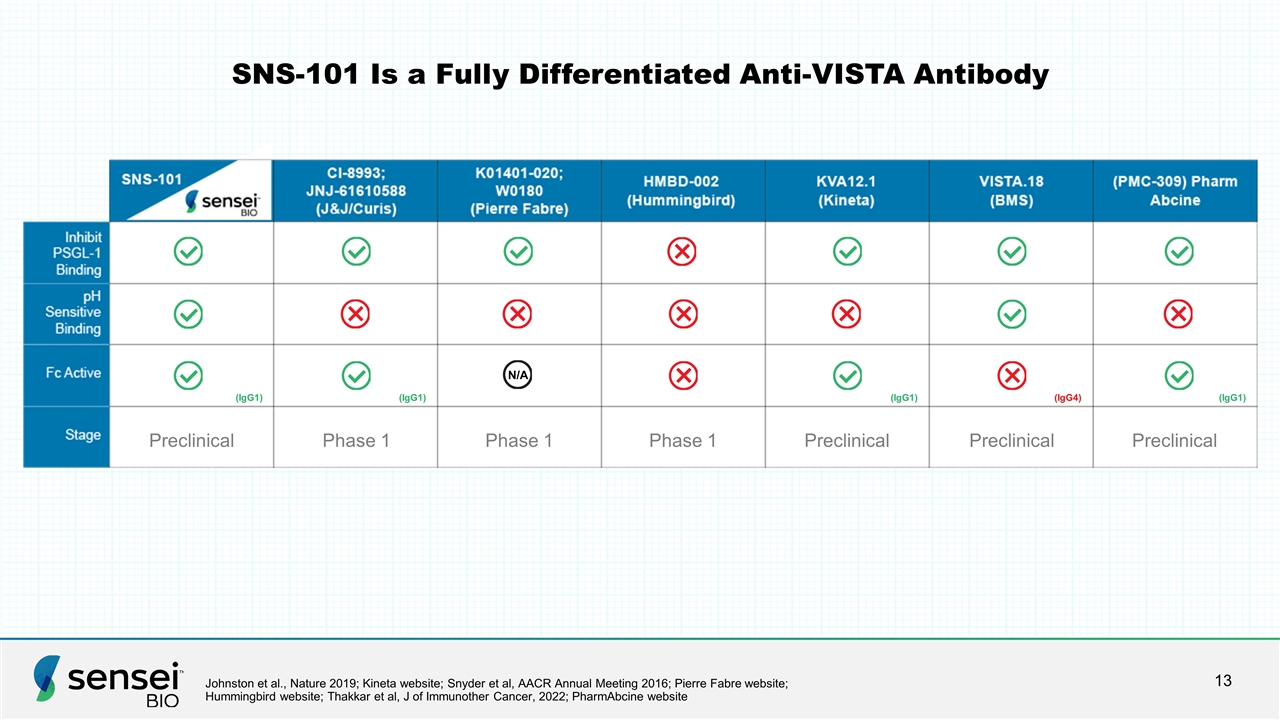
SNS-101 Is a Fully Differentiated Anti-VISTA Antibody Preclinical Phase 1 Phase 1 Phase 1 Preclinical Preclinical Preclinical (IgG1) (IgG1) (IgG1) (IgG4) (IgG1) Johnston et al., Nature 2019; Kineta website; Snyder et al, AACR Annual Meeting 2016; Pierre Fabre website; Hummingbird website; Thakkar et al, J of Immunother Cancer, 2022; PharmAbcine website
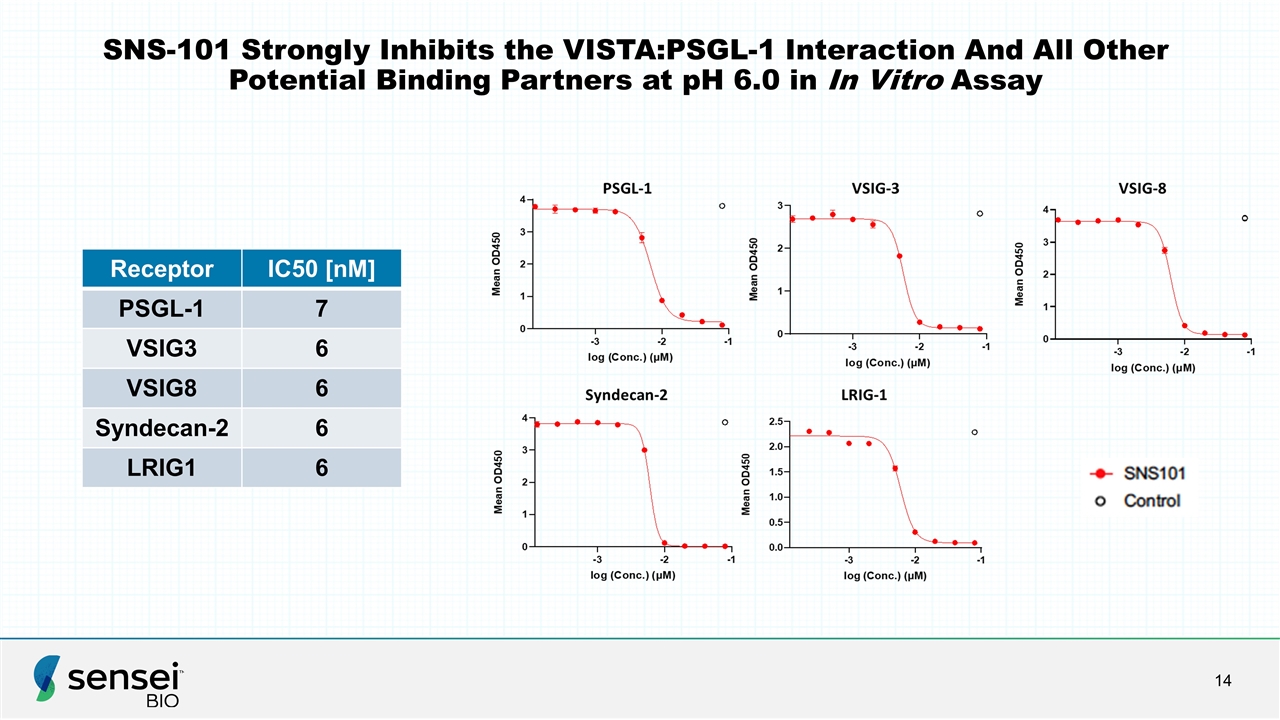
SNS-101 Strongly Inhibits the VISTA:PSGL-1 Interaction And All Other Potential Binding Partners at pH 6.0 in In Vitro Assay Receptor IC50 [nM] PSGL-1 7 VSIG3 6 VSIG8 6 Syndecan-2 6 LRIG1 6
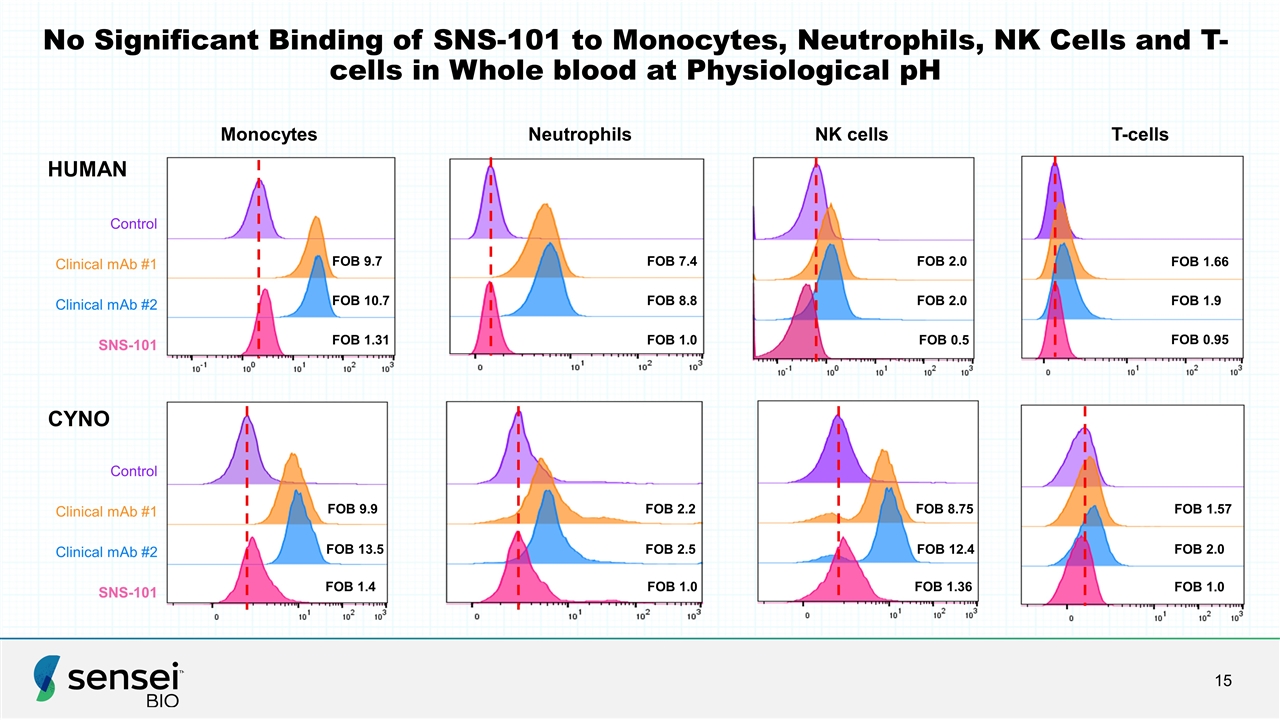
No Significant Binding of SNS-101 to Monocytes, Neutrophils, NK Cells and T-cells in Whole blood at Physiological pH T-cells NK cells FOB 1.57 FOB 2.0 FOB 1.0 FOB 8.75 FOB 12.4 FOB 1.36 Monocytes FOB 9.9 FOB 13.5 FOB 1.4 FOB 2.2 FOB 2.5 FOB 1.0 Neutrophils CYNO HUMAN FOB 7.4 FOB 8.8 FOB 1.0 Clinical mAb #1 Clinical mAb #2 SNS-101 Control FOB 2.0 FOB 2.0 FOB 0.5 Clinical mAb #1 Clinical mAb #2 SNS-101 Control FOB 1.66 FOB 1.9 FOB 0.95 FOB 9.7 FOB 10.7 FOB 1.31
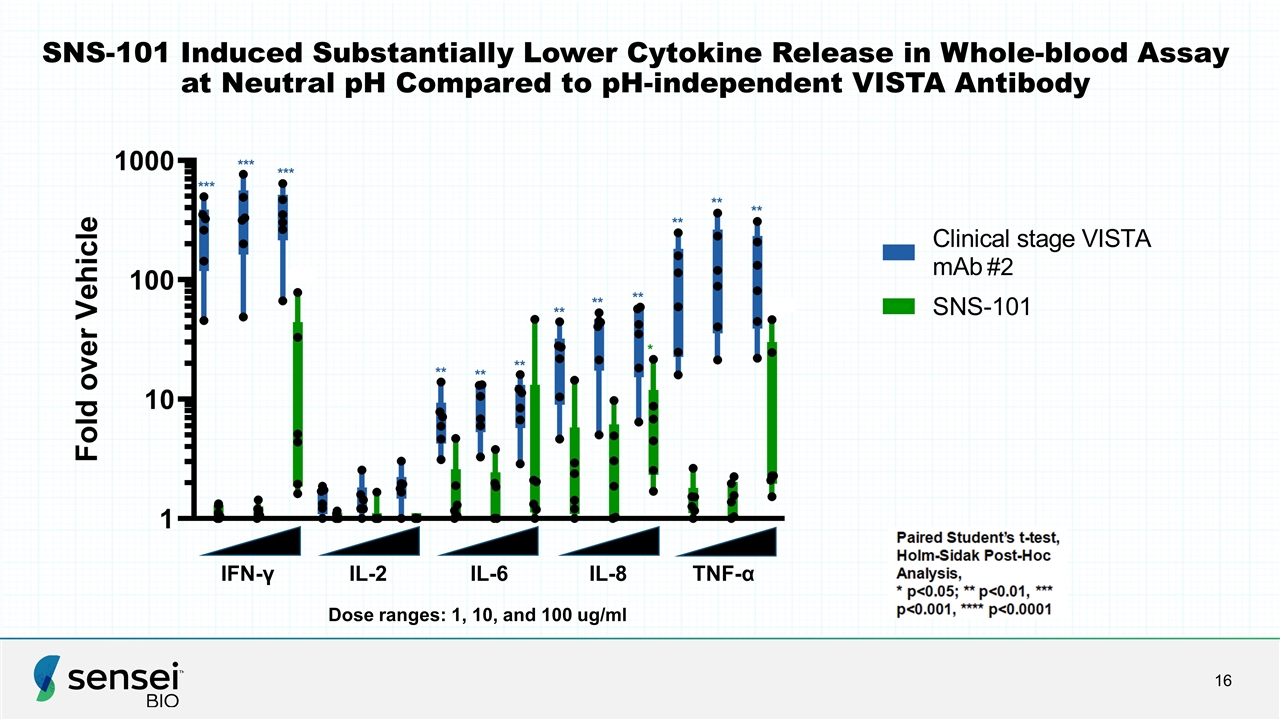
SNS-101 Induced Substantially Lower Cytokine Release in Whole-blood Assay at Neutral pH Compared to pH-independent VISTA Antibody IFN-γ IL-8 TNF-α IL-6 IL-2 *** *** *** ** * ** ** ** ** ** ** ** ** ** ** Dose ranges: 1, 10, and 100 ug/ml #2
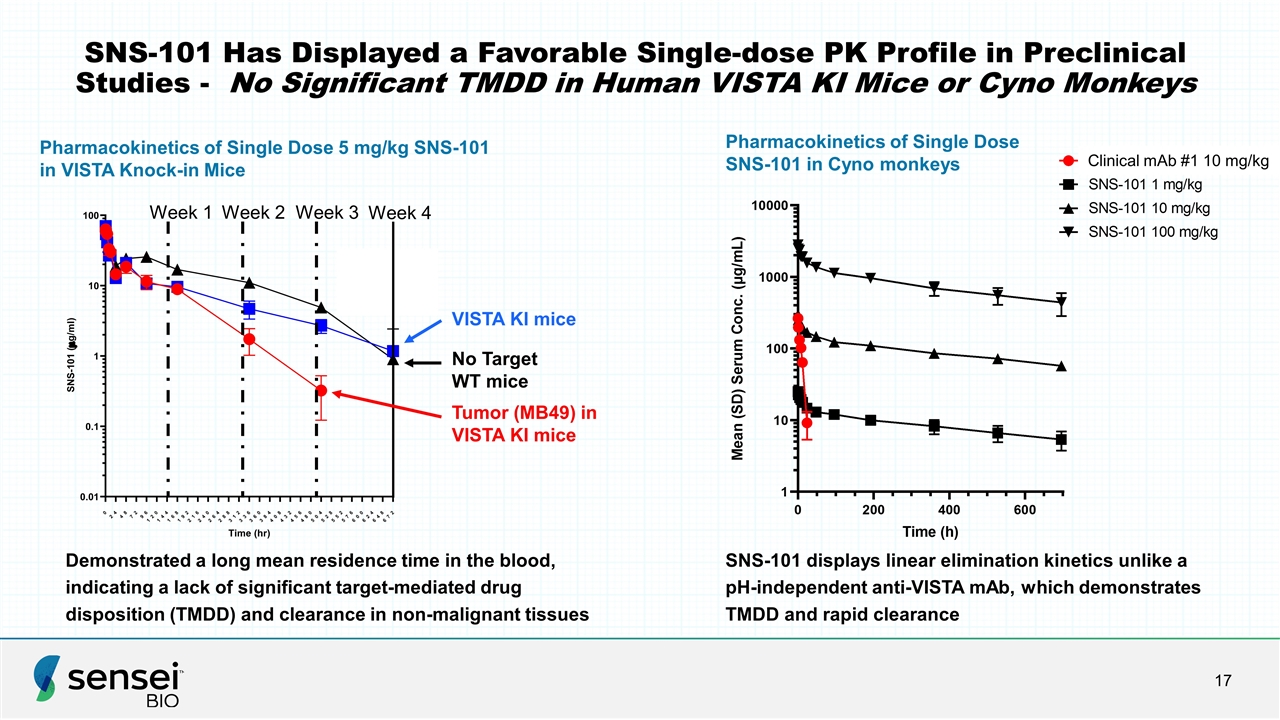
SNS-101 Has Displayed a Favorable Single-dose PK Profile in Preclinical Studies - No Significant TMDD in Human VISTA KI Mice or Cyno Monkeys Pharmacokinetics of Single Dose 5 mg/kg SNS-101 in VISTA Knock-in Mice Demonstrated a long mean residence time in the blood, indicating a lack of significant target-mediated drug disposition (TMDD) and clearance in non-malignant tissues Week 1 Week 2 Week 3 Week 4 Tumor (MB49) in VISTA KI mice VISTA KI mice No Target WT mice SNS-101 displays linear elimination kinetics unlike a pH-independent anti-VISTA mAb, which demonstrates TMDD and rapid clearance Pharmacokinetics of Single Dose SNS-101 in Cyno monkeys Clinical mAb #1 10 mg/kg
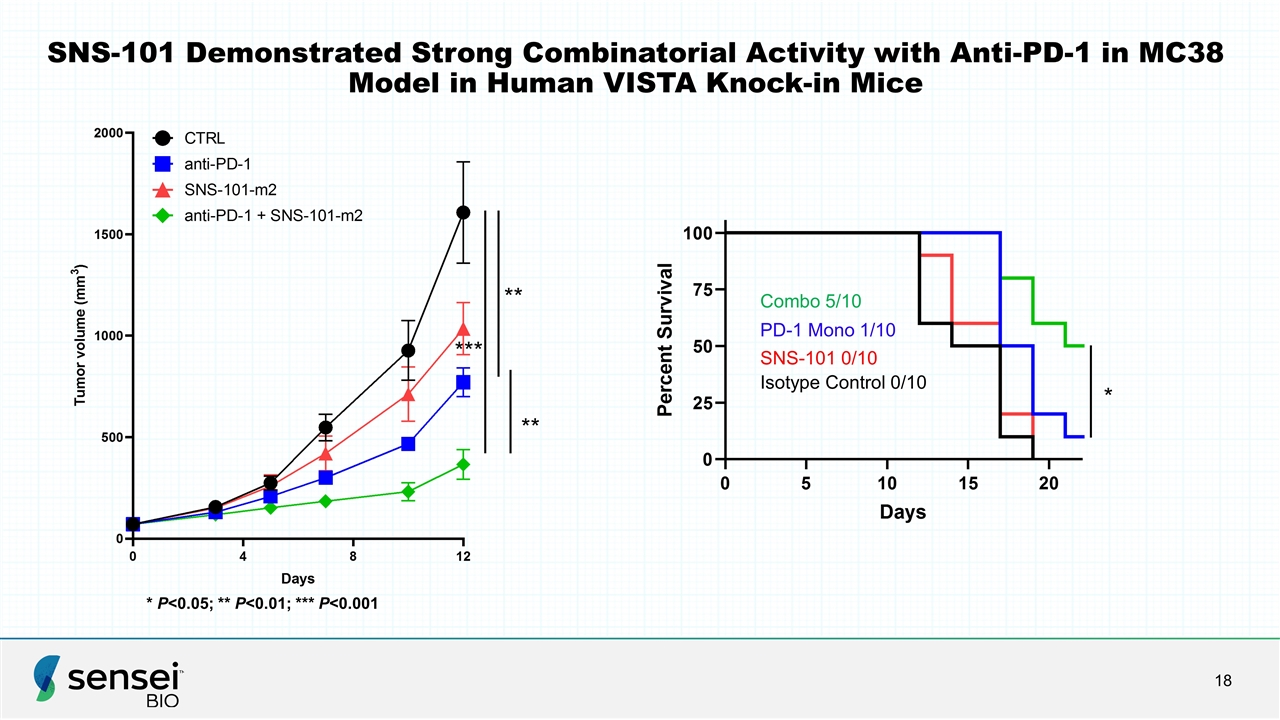
SNS-101 Demonstrated Strong Combinatorial Activity with Anti-PD-1 in MC38 Model in Human VISTA Knock-in Mice SNS-101 0/10 PD-1 Mono 1/10 Combo 5/10 Isotype Control 0/10 *** ** ** * P<0.05; ** P<0.01; *** P<0.001 *
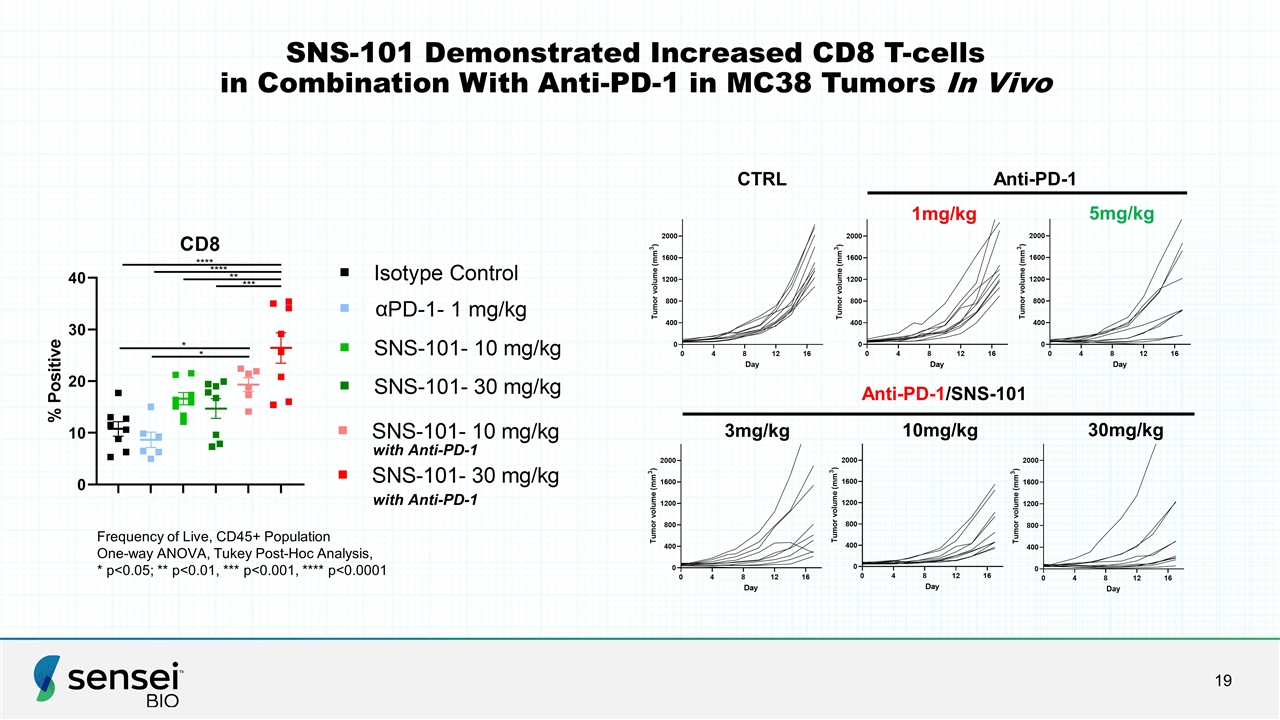
SNS-101 Demonstrated Increased CD8 T-cells in Combination With Anti-PD-1 in MC38 Tumors In Vivo CTRL Anti-PD-1 1mg/kg 5mg/kg Anti-PD-1/SNS-101 3mg/kg 10mg/kg 30mg/kg Frequency of Live, CD45+ Population One-way ANOVA, Tukey Post-Hoc Analysis, * p<0.05; ** p<0.01, *** p<0.001, **** p<0.0001 with Anti-PD-1 with Anti-PD-1 α
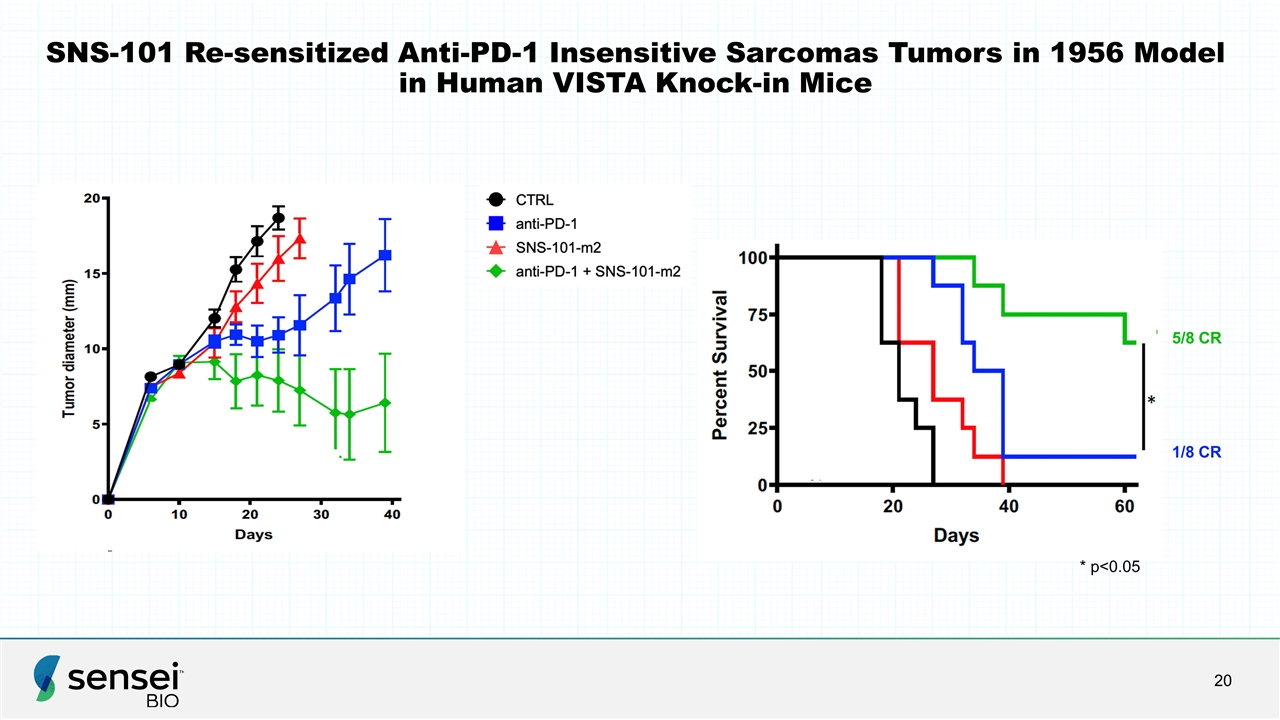
SNS-101 Re-sensitized Anti-PD-1 Insensitive Sarcomas Tumors in 1956 Model in Human VISTA Knock-in Mice 5/8 CR 1/8 CR * p<0.05
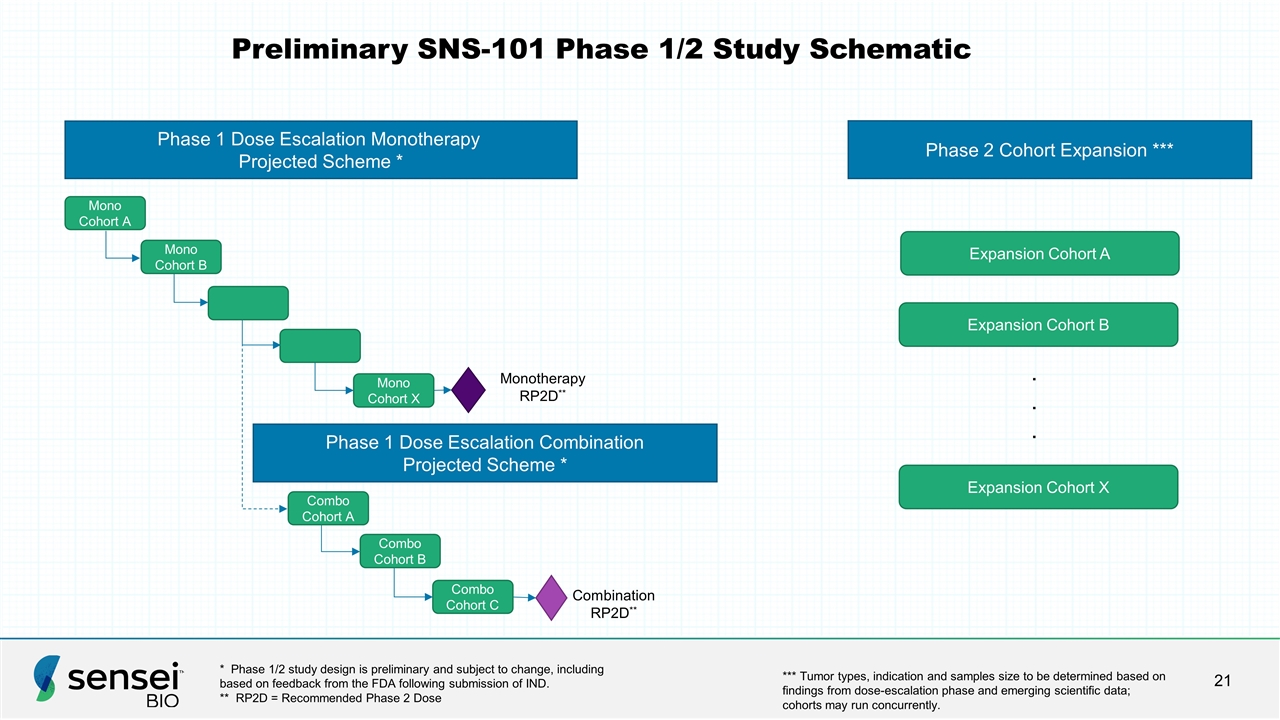
Preliminary SNS-101 Phase 1/2 Study Schematic 2 Phase 1 Dose Escalation Monotherapy Projected Scheme * Phase 2 Cohort Expansion *** *** Tumor types, indication and samples size to be determined based on findings from dose-escalation phase and emerging scientific data; cohorts may run concurrently. Phase 1 Dose Escalation Combination Projected Scheme * Monotherapy RP2D** Combination RP2D** Expansion Cohort A Expansion Cohort B Expansion Cohort X . . . Mono Cohort A Mono Cohort B Mono Cohort X Combo Cohort A Combo Cohort B Combo Cohort C * Phase 1/2 study design is preliminary and subject to change, including based on feedback from the FDA following submission of IND. ** RP2D = Recommended Phase 2 Dose
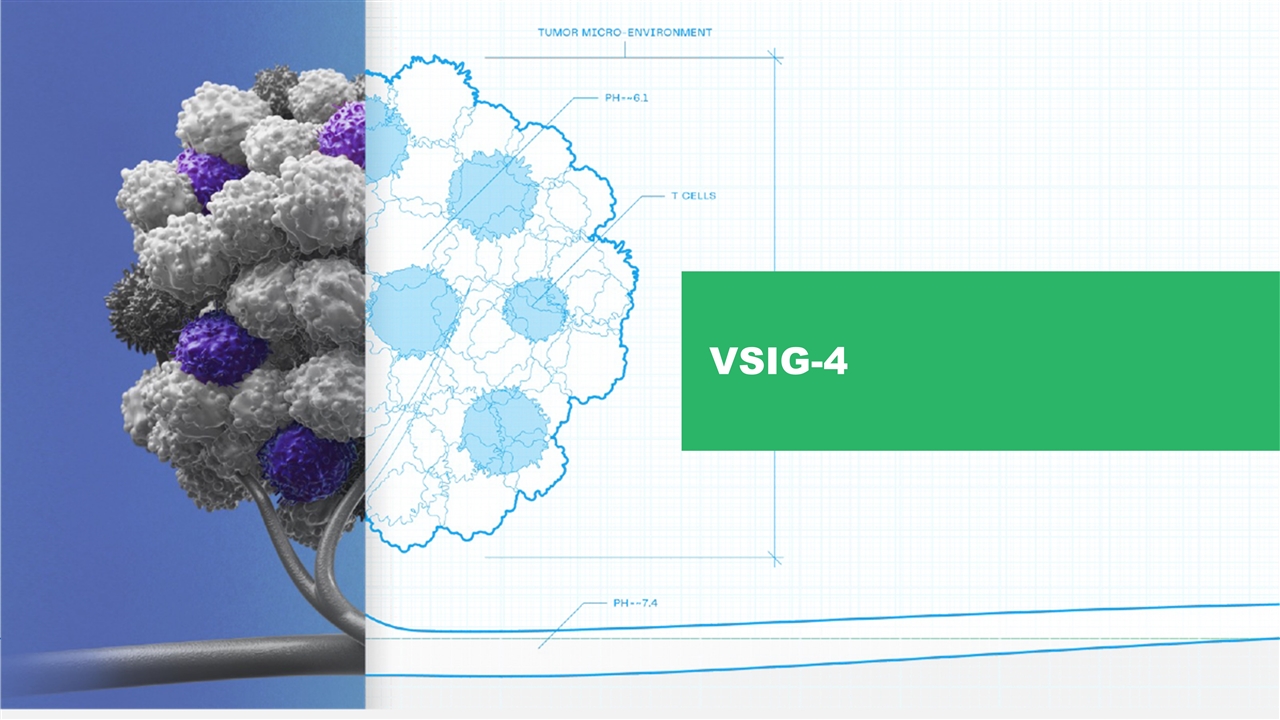
VSIG-4
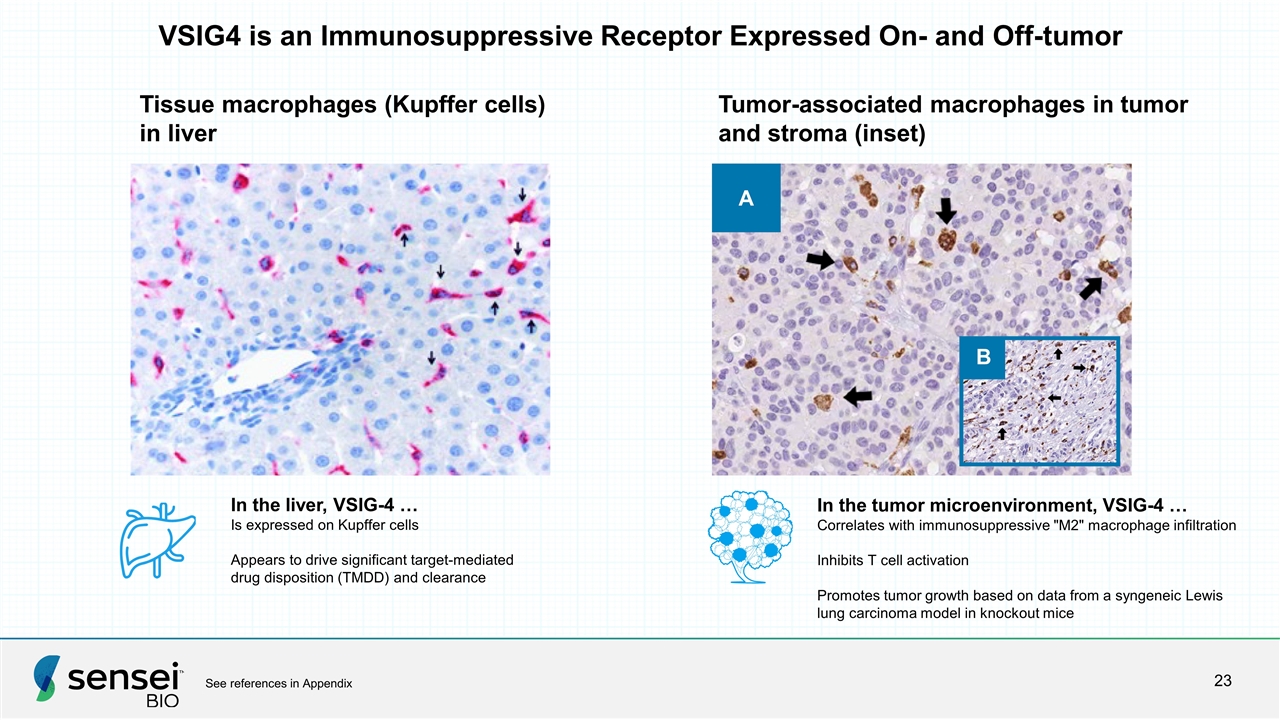
VSIG4 is an Immunosuppressive Receptor Expressed On- and Off-tumor See references in Appendix A B Tissue macrophages (Kupffer cells) in liver Tumor-associated macrophages in tumor and stroma (inset) In the liver, VSIG-4 … Is expressed on Kupffer cells Appears to drive significant target-mediated drug disposition (TMDD) and clearance In the tumor microenvironment, VSIG-4 … Correlates with immunosuppressive "M2" macrophage infiltration Inhibits T cell activation Promotes tumor growth based on data from a syngeneic Lewis lung carcinoma model in knockout mice
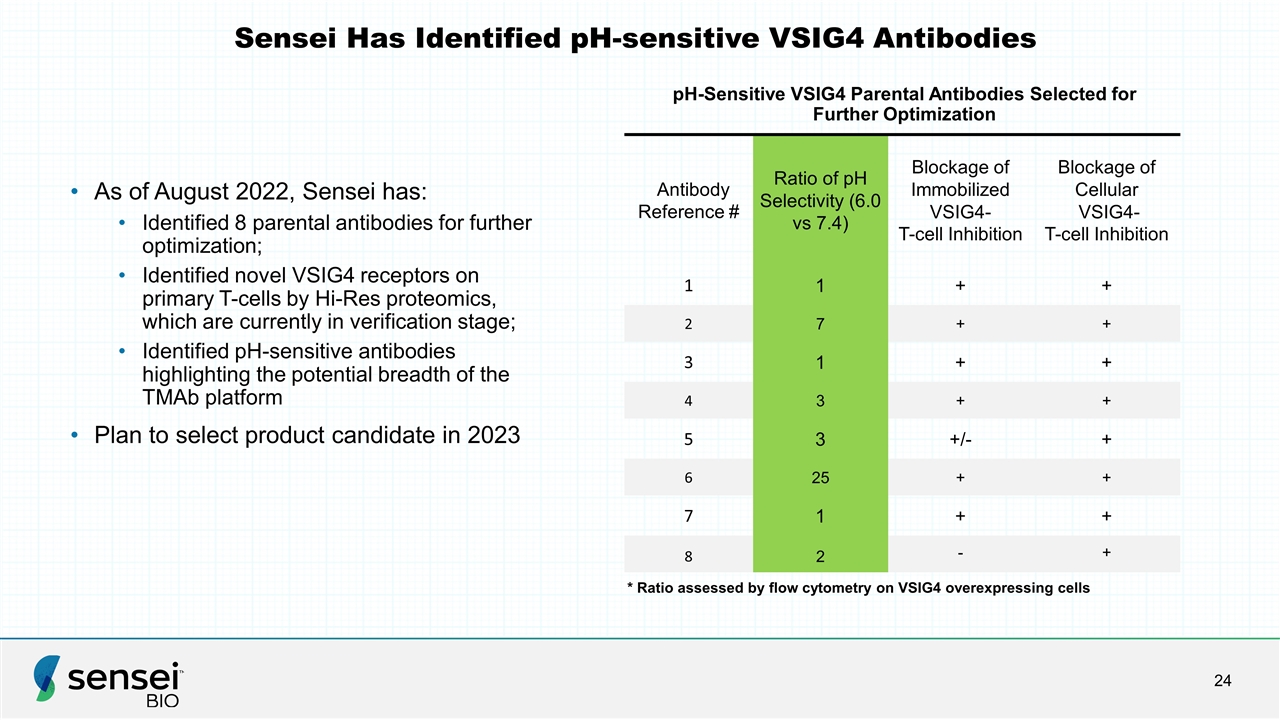
Sensei Has Identified pH-sensitive VSIG4 Antibodies pH-Sensitive VSIG4 Parental Antibodies Selected for Further Optimization Antibody Reference # Ratio of pH Selectivity (6.0 vs 7.4) Blockage of Immobilized VSIG4- T-cell Inhibition Blockage of Cellular VSIG4- T-cell Inhibition 1 1 + + 2 7 + + 3 1 + + 4 3 + + 5 3 +/- + 6 25 + + 7 1 + + 8 2 - + * Ratio assessed by flow cytometry on VSIG4 overexpressing cells As of August 2022, Sensei has: Identified 8 parental antibodies for further optimization; Identified novel VSIG4 receptors on primary T-cells by Hi-Res proteomics, which are currently in verification stage; Identified pH-sensitive antibodies highlighting the potential breadth of the TMAb platform Plan to select product candidate in 2023
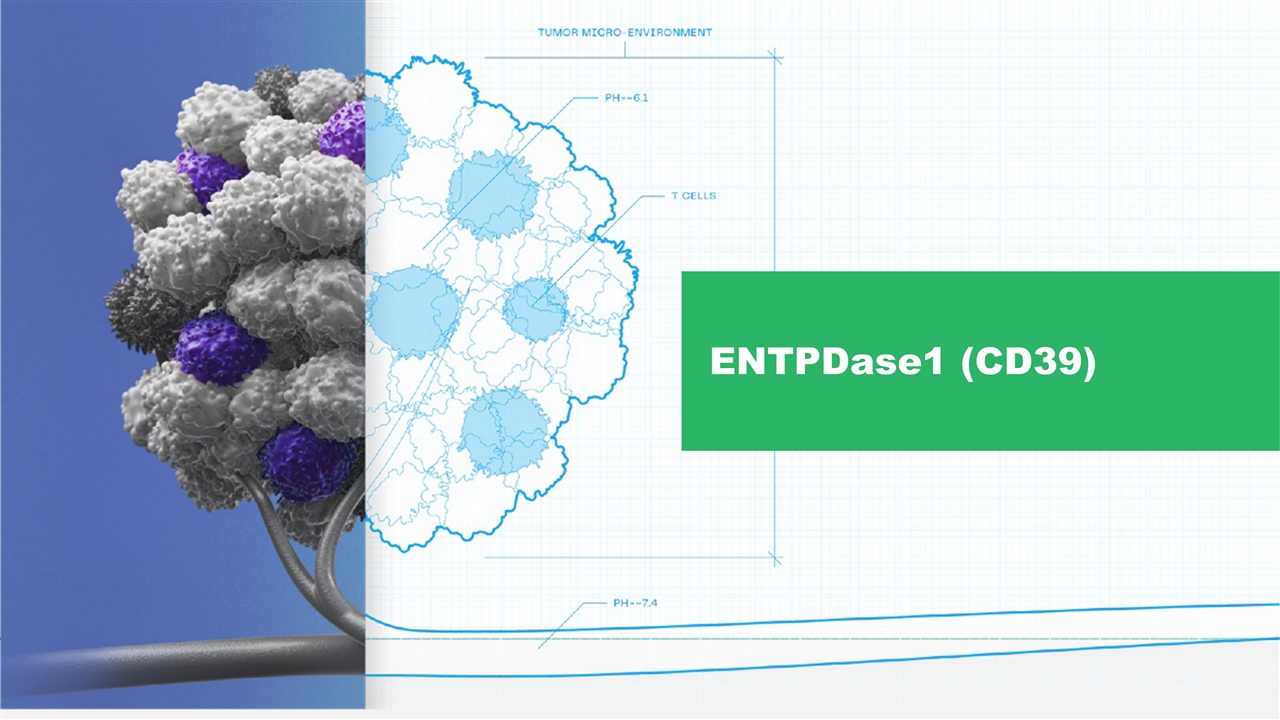
ENTPDase1 (CD39)
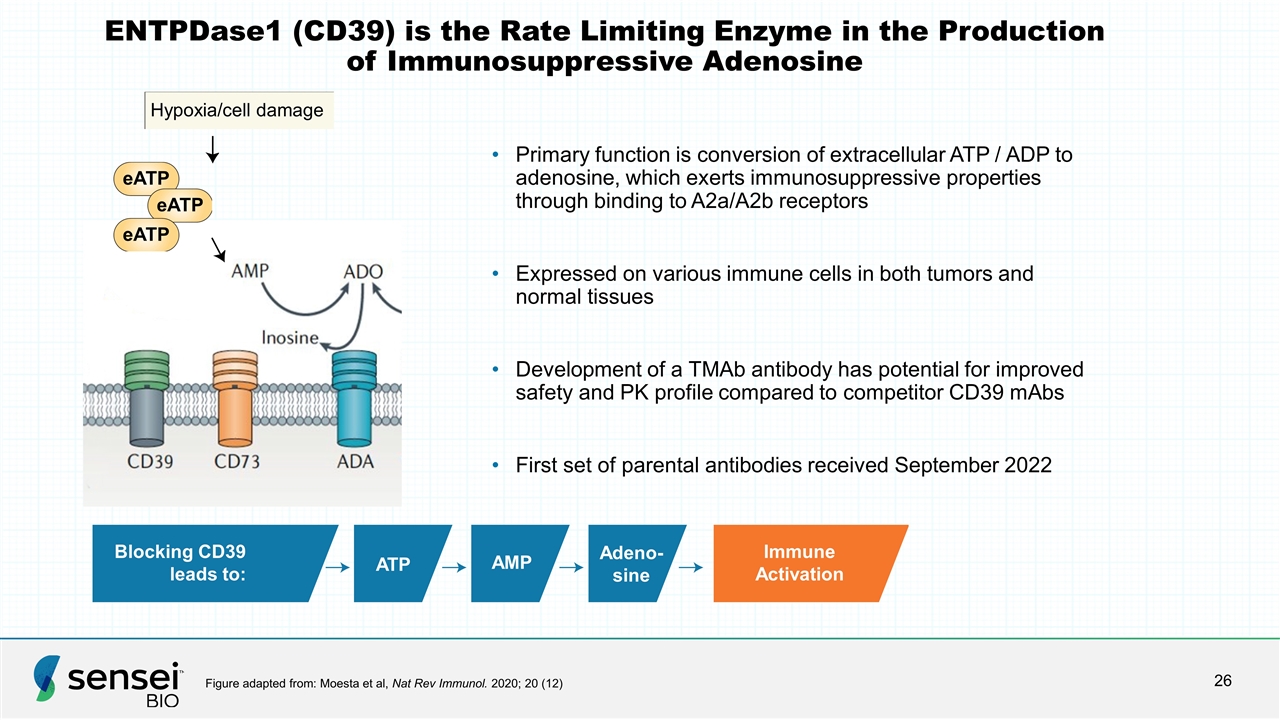
ENTPDase1 (CD39) is the Rate Limiting Enzyme in the Production of Immunosuppressive Adenosine Figure adapted from: Moesta et al, Nat Rev Immunol. 2020; 20 (12) Hypoxia/cell damage ATP AMP Adeno-sine Blocking CD39 leads to: Immune Activation Primary function is conversion of extracellular ATP / ADP to adenosine, which exerts immunosuppressive properties through binding to A2a/A2b receptors Expressed on various immune cells in both tumors and normal tissues Development of a TMAb antibody has potential for improved safety and PK profile compared to competitor CD39 mAbs First set of parental antibodies received September 2022
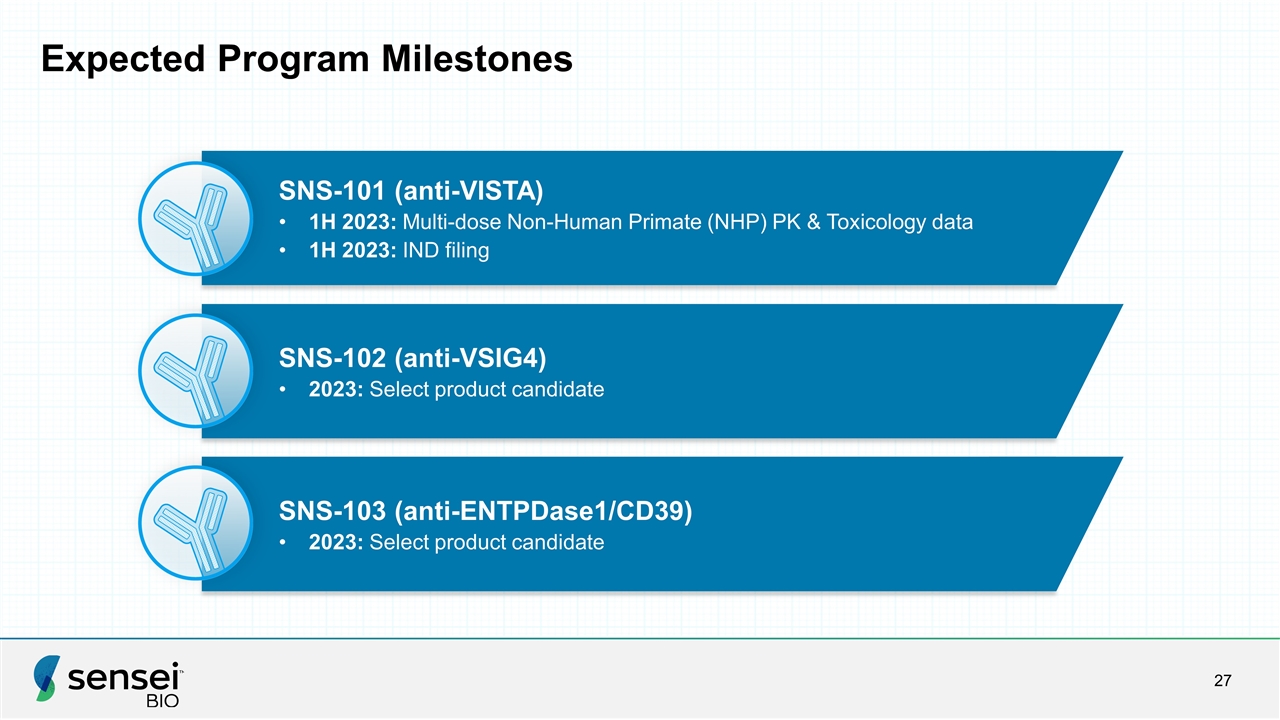
SNS-101 (anti-VISTA) 1H 2023: Multi-dose Non-Human Primate (NHP) PK & Toxicology data 1H 2023: IND filing SNS-102 (anti-VSIG4) 2023: Select product candidate SNS-103 (anti-ENTPDase1/CD39) 2023: Select product candidate Expected Program Milestones
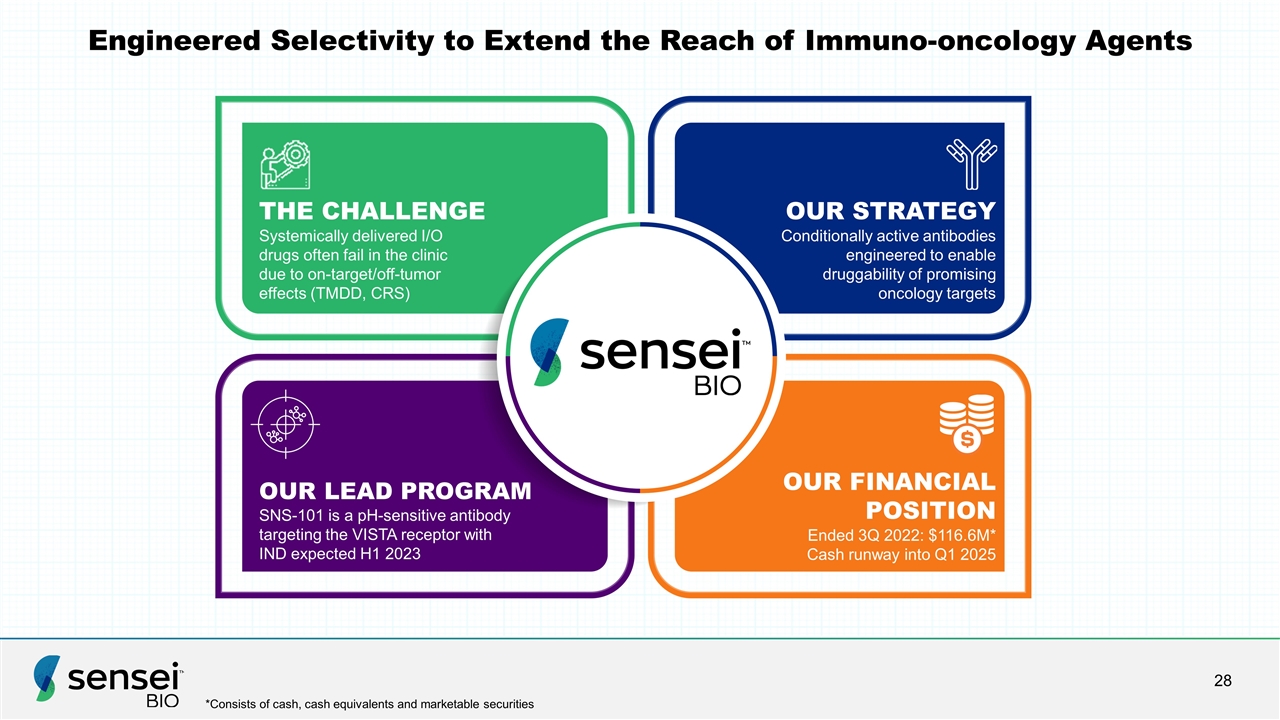
Engineered Selectivity to Extend the Reach of Immuno-oncology Agents THE CHALLENGE Systemically delivered I/O drugs often fail in the clinic due to on-target/off-tumor effects (TMDD, CRS) OUR FINANCIAL POSITION Ended 3Q 2022: $116.6M* Cash runway into Q1 2025 OUR STRATEGY Conditionally active antibodies engineered to enable druggability of promising oncology targets OUR LEAD PROGRAM SNS-101 is a pH-sensitive antibody targeting the VISTA receptor with IND expected H1 2023 *Consists of cash, cash equivalents and marketable securities
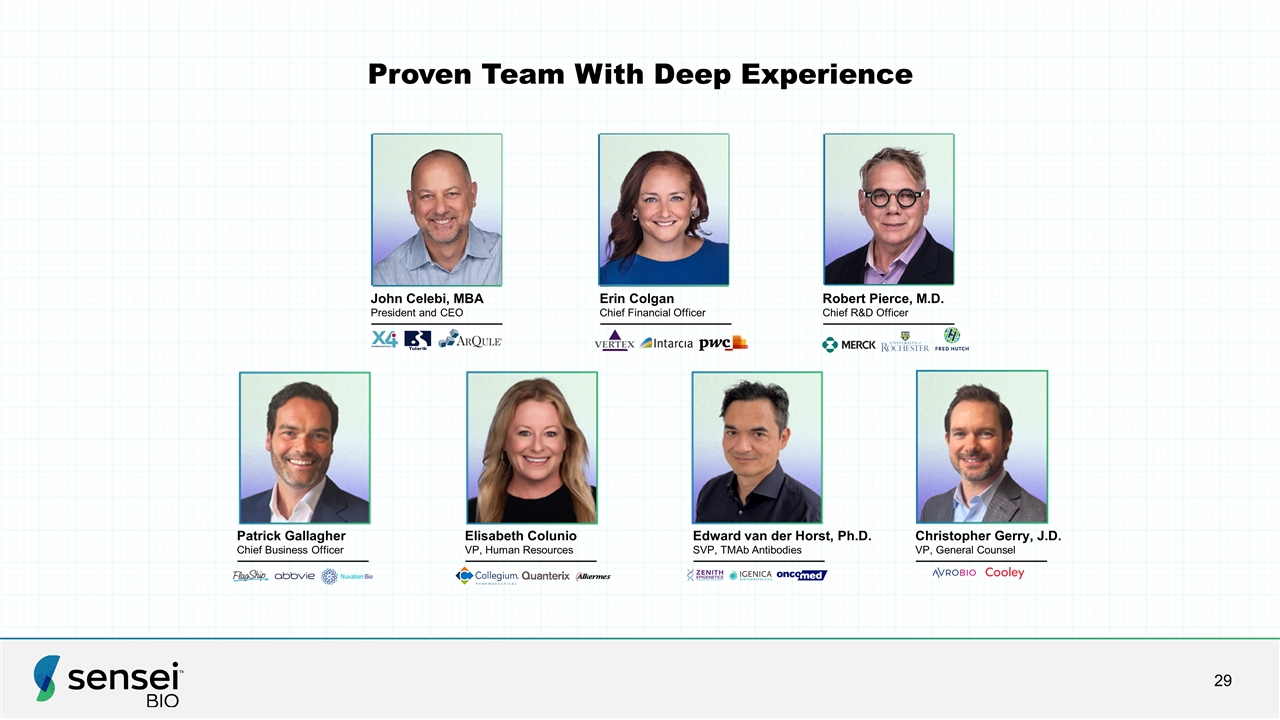
Proven Team With Deep Experience John Celebi, MBA President and CEO Erin Colgan Chief Financial Officer Robert Pierce, M.D. Chief R&D Officer Patrick Gallagher Chief Business Officer Elisabeth Colunio VP, Human Resources Edward van der Horst, Ph.D. SVP, TMAb Antibodies Christopher Gerry, J.D. VP, General Counsel
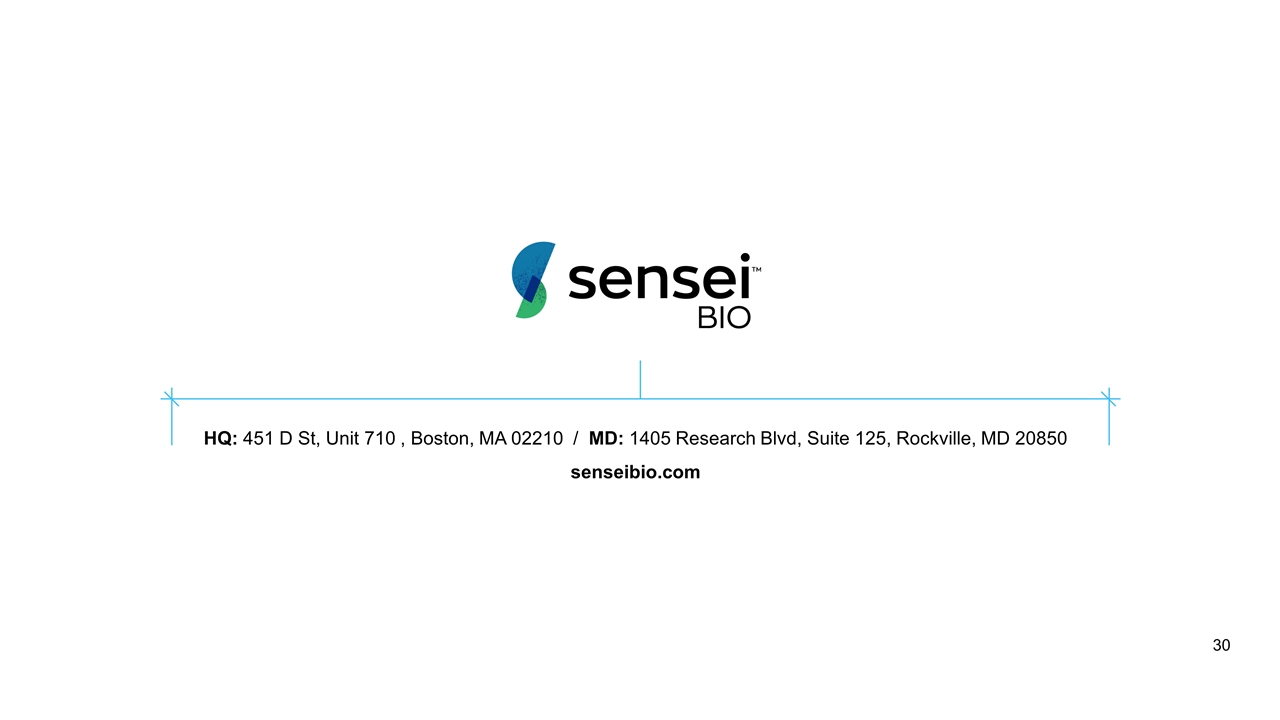
HQ: 451 D St, Unit 710 , Boston, MA 02210 / MD: 1405 Research Blvd, Suite 125, Rockville, MD 20850 senseibio.com
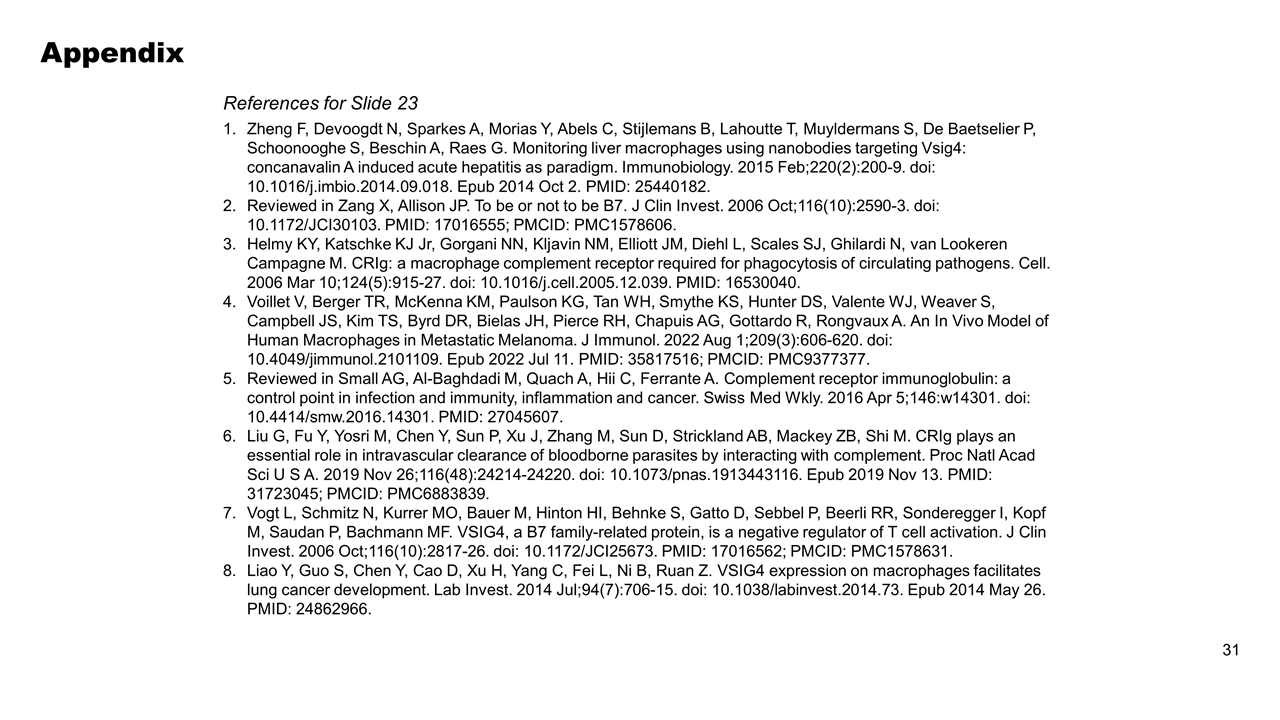
Appendix References for Slide 23 Zheng F, Devoogdt N, Sparkes A, Morias Y, Abels C, Stijlemans B, Lahoutte T, Muyldermans S, De Baetselier P, Schoonooghe S, Beschin A, Raes G. Monitoring liver macrophages using nanobodies targeting Vsig4: concanavalin A induced acute hepatitis as paradigm. Immunobiology. 2015 Feb;220(2):200-9. doi: 10.1016/j.imbio.2014.09.018. Epub 2014 Oct 2. PMID: 25440182. Reviewed in Zang X, Allison JP. To be or not to be B7. J Clin Invest. 2006 Oct;116(10):2590-3. doi: 10.1172/JCI30103. PMID: 17016555; PMCID: PMC1578606. Helmy KY, Katschke KJ Jr, Gorgani NN, Kljavin NM, Elliott JM, Diehl L, Scales SJ, Ghilardi N, van Lookeren Campagne M. CRIg: a macrophage complement receptor required for phagocytosis of circulating pathogens. Cell. 2006 Mar 10;124(5):915-27. doi: 10.1016/j.cell.2005.12.039. PMID: 16530040. Voillet V, Berger TR, McKenna KM, Paulson KG, Tan WH, Smythe KS, Hunter DS, Valente WJ, Weaver S, Campbell JS, Kim TS, Byrd DR, Bielas JH, Pierce RH, Chapuis AG, Gottardo R, Rongvaux A. An In Vivo Model of Human Macrophages in Metastatic Melanoma. J Immunol. 2022 Aug 1;209(3):606-620. doi: 10.4049/jimmunol.2101109. Epub 2022 Jul 11. PMID: 35817516; PMCID: PMC9377377. Reviewed in Small AG, Al-Baghdadi M, Quach A, Hii C, Ferrante A. Complement receptor immunoglobulin: a control point in infection and immunity, inflammation and cancer. Swiss Med Wkly. 2016 Apr 5;146:w14301. doi: 10.4414/smw.2016.14301. PMID: 27045607. Liu G, Fu Y, Yosri M, Chen Y, Sun P, Xu J, Zhang M, Sun D, Strickland AB, Mackey ZB, Shi M. CRIg plays an essential role in intravascular clearance of bloodborne parasites by interacting with complement. Proc Natl Acad Sci U S A. 2019 Nov 26;116(48):24214-24220. doi: 10.1073/pnas.1913443116. Epub 2019 Nov 13. PMID: 31723045; PMCID: PMC6883839. Vogt L, Schmitz N, Kurrer MO, Bauer M, Hinton HI, Behnke S, Gatto D, Sebbel P, Beerli RR, Sonderegger I, Kopf M, Saudan P, Bachmann MF. VSIG4, a B7 family-related protein, is a negative regulator of T cell activation. J Clin Invest. 2006 Oct;116(10):2817-26. doi: 10.1172/JCI25673. PMID: 17016562; PMCID: PMC1578631. Liao Y, Guo S, Chen Y, Cao D, Xu H, Yang C, Fei L, Ni B, Ruan Z. VSIG4 expression on macrophages facilitates lung cancer development. Lab Invest. 2014 Jul;94(7):706-15. doi: 10.1038/labinvest.2014.73. Epub 2014 May 26. PMID: 24862966.






























